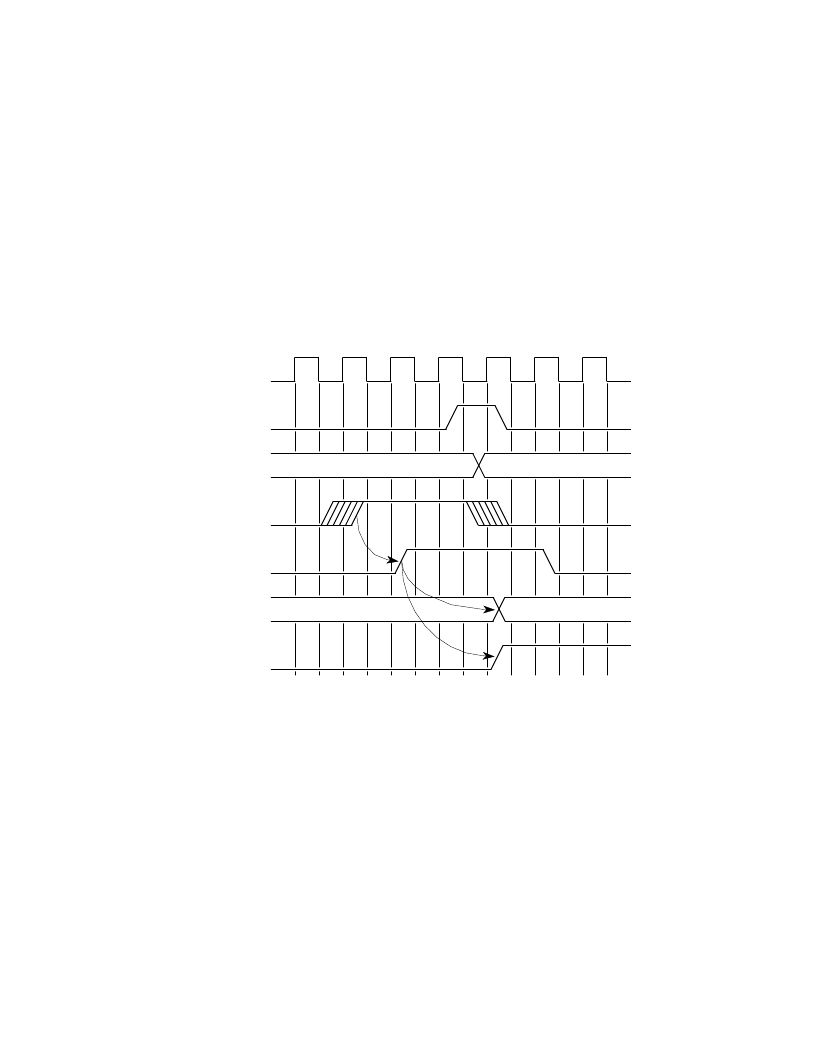- 您現(xiàn)在的位置:買賣IC網(wǎng) > PDF目錄371043 > MC68331CPV16 (MOTOROLA INC) User’s Manual PDF資料下載
參數(shù)資料
| 型號(hào): | MC68331CPV16 |
| 廠商: | MOTOROLA INC |
| 元件分類: | 微控制器/微處理器 |
| 英文描述: | User’s Manual |
| 中文描述: | 32-BIT, 16.78 MHz, MICROCONTROLLER, PQFP144 |
| 封裝: | TQFP-144 |
| 文件頁(yè)數(shù): | 170/254頁(yè) |
| 文件大小: | 1354K |
| 代理商: | MC68331CPV16 |
第1頁(yè)第2頁(yè)第3頁(yè)第4頁(yè)第5頁(yè)第6頁(yè)第7頁(yè)第8頁(yè)第9頁(yè)第10頁(yè)第11頁(yè)第12頁(yè)第13頁(yè)第14頁(yè)第15頁(yè)第16頁(yè)第17頁(yè)第18頁(yè)第19頁(yè)第20頁(yè)第21頁(yè)第22頁(yè)第23頁(yè)第24頁(yè)第25頁(yè)第26頁(yè)第27頁(yè)第28頁(yè)第29頁(yè)第30頁(yè)第31頁(yè)第32頁(yè)第33頁(yè)第34頁(yè)第35頁(yè)第36頁(yè)第37頁(yè)第38頁(yè)第39頁(yè)第40頁(yè)第41頁(yè)第42頁(yè)第43頁(yè)第44頁(yè)第45頁(yè)第46頁(yè)第47頁(yè)第48頁(yè)第49頁(yè)第50頁(yè)第51頁(yè)第52頁(yè)第53頁(yè)第54頁(yè)第55頁(yè)第56頁(yè)第57頁(yè)第58頁(yè)第59頁(yè)第60頁(yè)第61頁(yè)第62頁(yè)第63頁(yè)第64頁(yè)第65頁(yè)第66頁(yè)第67頁(yè)第68頁(yè)第69頁(yè)第70頁(yè)第71頁(yè)第72頁(yè)第73頁(yè)第74頁(yè)第75頁(yè)第76頁(yè)第77頁(yè)第78頁(yè)第79頁(yè)第80頁(yè)第81頁(yè)第82頁(yè)第83頁(yè)第84頁(yè)第85頁(yè)第86頁(yè)第87頁(yè)第88頁(yè)第89頁(yè)第90頁(yè)第91頁(yè)第92頁(yè)第93頁(yè)第94頁(yè)第95頁(yè)第96頁(yè)第97頁(yè)第98頁(yè)第99頁(yè)第100頁(yè)第101頁(yè)第102頁(yè)第103頁(yè)第104頁(yè)第105頁(yè)第106頁(yè)第107頁(yè)第108頁(yè)第109頁(yè)第110頁(yè)第111頁(yè)第112頁(yè)第113頁(yè)第114頁(yè)第115頁(yè)第116頁(yè)第117頁(yè)第118頁(yè)第119頁(yè)第120頁(yè)第121頁(yè)第122頁(yè)第123頁(yè)第124頁(yè)第125頁(yè)第126頁(yè)第127頁(yè)第128頁(yè)第129頁(yè)第130頁(yè)第131頁(yè)第132頁(yè)第133頁(yè)第134頁(yè)第135頁(yè)第136頁(yè)第137頁(yè)第138頁(yè)第139頁(yè)第140頁(yè)第141頁(yè)第142頁(yè)第143頁(yè)第144頁(yè)第145頁(yè)第146頁(yè)第147頁(yè)第148頁(yè)第149頁(yè)第150頁(yè)第151頁(yè)第152頁(yè)第153頁(yè)第154頁(yè)第155頁(yè)第156頁(yè)第157頁(yè)第158頁(yè)第159頁(yè)第160頁(yè)第161頁(yè)第162頁(yè)第163頁(yè)第164頁(yè)第165頁(yè)第166頁(yè)第167頁(yè)第168頁(yè)第169頁(yè)當(dāng)前第170頁(yè)第171頁(yè)第172頁(yè)第173頁(yè)第174頁(yè)第175頁(yè)第176頁(yè)第177頁(yè)第178頁(yè)第179頁(yè)第180頁(yè)第181頁(yè)第182頁(yè)第183頁(yè)第184頁(yè)第185頁(yè)第186頁(yè)第187頁(yè)第188頁(yè)第189頁(yè)第190頁(yè)第191頁(yè)第192頁(yè)第193頁(yè)第194頁(yè)第195頁(yè)第196頁(yè)第197頁(yè)第198頁(yè)第199頁(yè)第200頁(yè)第201頁(yè)第202頁(yè)第203頁(yè)第204頁(yè)第205頁(yè)第206頁(yè)第207頁(yè)第208頁(yè)第209頁(yè)第210頁(yè)第211頁(yè)第212頁(yè)第213頁(yè)第214頁(yè)第215頁(yè)第216頁(yè)第217頁(yè)第218頁(yè)第219頁(yè)第220頁(yè)第221頁(yè)第222頁(yè)第223頁(yè)第224頁(yè)第225頁(yè)第226頁(yè)第227頁(yè)第228頁(yè)第229頁(yè)第230頁(yè)第231頁(yè)第232頁(yè)第233頁(yè)第234頁(yè)第235頁(yè)第236頁(yè)第237頁(yè)第238頁(yè)第239頁(yè)第240頁(yè)第241頁(yè)第242頁(yè)第243頁(yè)第244頁(yè)第245頁(yè)第246頁(yè)第247頁(yè)第248頁(yè)第249頁(yè)第250頁(yè)第251頁(yè)第252頁(yè)第253頁(yè)第254頁(yè)

MOTOROLA
7-12
GENERAL-PURPOSE TIMER
MC68331
USER’S MANUAL
7
synchronized with the system clock so that latching of TCNT content and counter in-
crementation occur on opposite half-cycles of the system clock. Inputs have hystere-
sis. Capture of any transition longer than two system clocks is guaranteed; any
transition shorter than one system clock has no effect.
Figure 7-4
shows the relationship of system clock to synchronizer output. The value
latched into the capture register is the value of the counter several system clock cycles
after the transition that triggers the edge detection logic. There can be up to one clock
cycle of uncertainty in latching of the input transition. Maximum time is determined by
the system clock frequency.
The input capture register is a 16-bit register. A word access is required to ensure co-
herency. If coherency is not required, byte accesses can be used to read the register.
Input capture registers can be read at any time without affecting their values.
Figure 7-4 Input Capture Timing Example
An input capture occurs every time a selected edge is detected, even when the input
capture status flag is set. This means that the value read from the input capture regis-
ter corresponds to the most recent edge detected, which may not be the edge that
caused the status flag to be set.
7.8.3 Output Compare Functions
Each GPT output compare pin has an associated 16-bit compare register and a 16-bit
comparator. Each output compare function has an associated status flag, and can
cause the GPT to make an interrupt service request. Output compare logic is designed
to prevent false compares during data transition times.
1153A
CAPTURE/COMPARE
CLOCK
CAPTURE REGISTER
$0102
SYNCHRONIZER
OUTPUT
ICF FLAG
EXTERNAL PIN
TCNT
$0102
$0101
F
SYS
(PH1)
相關(guān)PDF資料 |
PDF描述 |
|---|---|
| MC68331MFV20 | User’s Manual |
| MC68331MPV16 | User’s Manual |
| MC68331MPV20 | User’s Manual |
| MC68331VFC16 | User’s Manual |
| MC68331VFC20 | User’s Manual |
相關(guān)代理商/技術(shù)參數(shù) |
參數(shù)描述 |
|---|---|
| MC68331CPV16B1 | 制造商:Rochester Electronics LLC 功能描述:32BIT MCU,GPT,SIM,QSM - Bulk |
| MC68331CPV20 | 制造商:Rochester Electronics LLC 功能描述:32BIT MCU,GPT,SIM,QSM - Bulk |
| MC68331CPV20B1 | 制造商:Rochester Electronics LLC 功能描述:32BIT MCU,GPT,SIM,QSM - Bulk |
| MC68331CPV25 | 制造商:Rochester Electronics LLC 功能描述:32BIT MCU,GPT,SIM,QSM - Bulk |
| MC68331LPV20 | 制造商:Motorola Inc 功能描述: |
發(fā)布緊急采購(gòu),3分鐘左右您將得到回復(fù)。